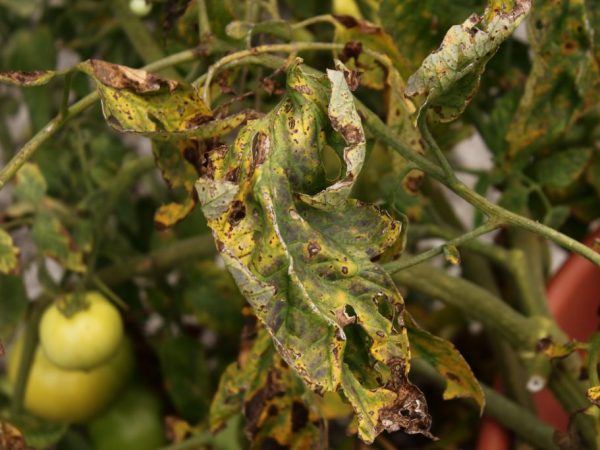Help for drying and yellowing tomatoes
One of the common problems that garden owners face is when tomatoes dry and turn yellow. Why is this happening and what to do to avoid these problems? What reasons, besides natural aging, solar overheating and late blight infection, can lead to wilting of tomato, which until recently looked fresh?

Help for drying and yellowing tomatoes
Damaged roots
One can suspect that the plant's rhizome is in danger if only the lower leaves have changed. The rest of the tomato has a blooming appearance.
Probably, the damage was due to the fault of the gardener, who was careless with the tomato, too actively wielding a hoe. The rhizome consists of an oblong central root, with which the plant feeds moisture from the bottom of the soil during drought, and an accumulation of small feeding roots at the very top of the underground layer. By weeding the soil, gardeners often touch this system.
Mulching technique
To protect the layer, you can turn to the mulching technique, then during loosening the chances of touching the rhizome will significantly decrease. In the meantime, you will have to wait for the damaged elements to grow back and the tomato to recover. But you can't do anything with the leaves - you just have to cut them off if the tomatoes turn yellow and dry.
Moisture deficiency
The gradual wilting of foliage, loss of firmness, curling and flaking means that the tomato is not getting enough moisture. The farmer is to blame for this. There are a number of possible causes of a disaster:
- the central root touched during planting in the ground, after which it usually begins to build up the surface layer;
- frequent watering of young stock with a small amount of liquid / irregular irrigation system.
An injured or damaged root is often unable to provide water for the plant. Therefore, it should be handled with care.
Irrigation system
As for frequent watering, it is also important to know when to stop. Tomatoes must be able to provide themselves with moisture, otherwise they will climb to the very surface. If you suddenly stop soldering the leaves, they will turn yellow and dry out. Therefore, you will have to not change the system and continue to pamper your tomatoes until the end of the season / growing season.
Malnutrition
Conscientious owners, fearing to overload vegetables with chemistry, use exclusively organic fertilizers like rotted manure for feeding.
The need for feeding
Whatever one may say, but in order to get a large amount of the crop, you will have to do top dressing with such microelements as calcium, magnesium, boron. Nothing bad will happen if you follow the recommended doses and make recharge after rain and watering.
It is not difficult to recognize the deficiency of nutrients in a plant: leaves on tomatoes turn yellow, turn red and dry. Further, the phenomenon gradually affects the entire area, the foliage changes color, dries up and crumbles.
Fusarium infection

Affected plant can infect nearby bushes
The leaves of tomatoes begin to brighten, then turn yellow, shrink and fall off the stem. First, the lower specimens are affected, then Fusarium goes up. Unfortunately, it is pointless to treat the disease with folk remedies6, do not waste time, because an infected tomato under the influence of fusarium not only dies on its own, but also takes neighbors with it.
Helping tomatoes
The gardener has two choices. You can pull out all infected tomatoes, or you can treat them with fungicides. Rather, these substances only inhibit the development of viral bacteria, giving the plant the opportunity to fight the disease itself.
Prophylaxis
It is known that it is easier to prevent a disease than to fight it. What are the preventive measures so that the tomato leaves do not dry out and turn yellow?
Plants are infected with Fusarium usually in July. High air temperature and excessive humidity levels are the best way to promote the growth of bacteria. From the moment the seeds are planted in the soil, your future harvest should be secured. Start by disinfecting seeds, soil, and containers, as disinfection conditions make it harder for bacteria to survive. At the first stage (one month before planting), use potassium permanganate, then, two weeks later - phytosporin. Already on the 15th day after planting, regularly treat tomatoes with biofungicides. Also, protecting tomatoes from bacteria, do not plant too thick, get rid of the lower leaves in time and avoid too abundant watering. Such simple measures will significantly reduce the risk of developing fusarium disease in your seedlings.
Hypothermia
Even covering the plants with a cloth or film will not save them from the cold outdoors. Therefore, observe the timing of planting seeds specifically for your region, plant in greenhouses and greenhouses, refer to early ripening varieties.
Signs
If the tomatoes still managed to suffer from the influence of low temperatures, this will be noticeable by the following signs:
- slowdown in growth;
- widespread yellowing of the leaves;
- a bluish border;
- reddening of the stem in some cases.
You can try to save the fruit by spraying with adaptogens like aloe or zircon - just one drop per liter of water is enough.
Bad light
Such a diagnosis should be suspected when the leaves of tomatoes begin to crumble, turn yellow, and lose strength. Shoots fade. Flowering stops. The solution is simple: add light. If your seedlings are outdoors, make a reflector from foil and plywood sheets. The surface must reflect the sun's rays - this is necessary for the normal growth and development of plants. As soon as the tomatoes stop stretching and the leaves turn yellow, the structure can be removed.
Remember that tomato leaves turn yellow and dry for a reason. Proper care will protect you from unnecessary problems with seedlings.


